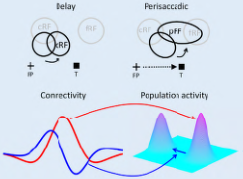You are here
Receptive-field Remapping and Space Representation Across Saccades
Speakers
Abstract
The nature and function of perisaccadic receptive-field (RF) remapping have been controversial. We used a delayed saccade task to reduce previous confounds and examined the remapping time course in areas LIP and FEF. In the delay period, the RF shift direction turned from the initial fixation to the saccade target. In the perisaccadic period, RFs first shifted toward the target (convergent remapping) but around the time of saccade onset/offset, the shifts became predominantly toward the post-saccadic RF locations (forward remapping). Thus, unlike forward remapping that depends on the corollary discharge (CD) of the saccade command, convergent remapping appears to follow attention from the initial fixation to the target. We modelled the data with attention-modulated and CD-gated connections, and showed that both sets of connections emerge automatically in neural networks trained to update stimulus retinal locations across saccades. The model also explains the translational component of perisaccadic perceptual mislocalization as imperfect updating for flashes around saccades. Our work thus integrates seemingly contradictory findings into a computational mechanism for transsaccadic space representation. The work suggests that the brain uses "unaware" decoders that interpret a cell’s response in the same way regardless of whether the response is from the stimulation of the cell’s RF or remapped laterally from elsewhere. (Joint work with Mingsha Zhang and Mickey Goldberg's labs)


